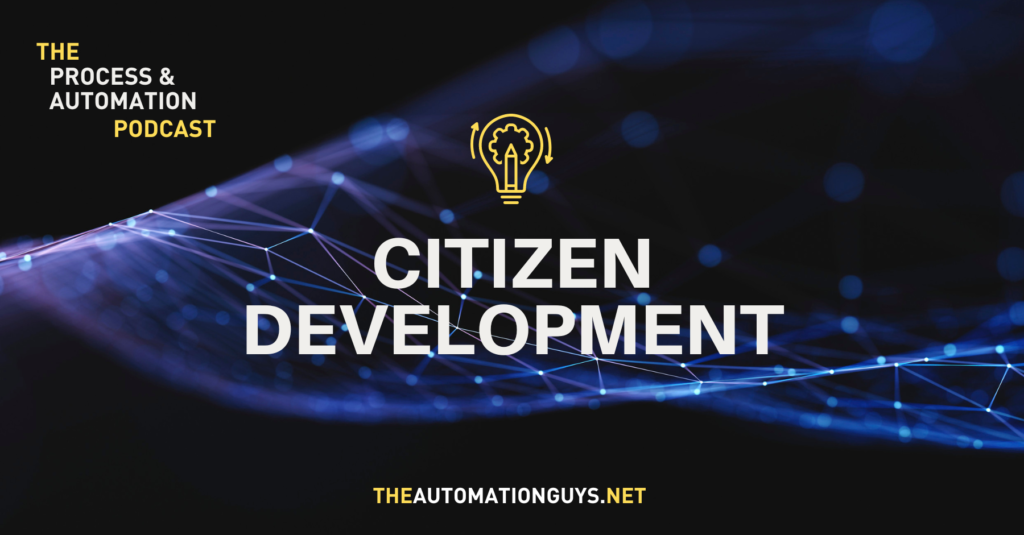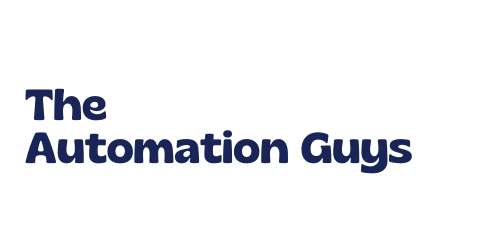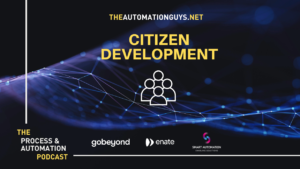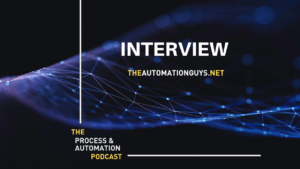Blog

#62 Five Steps to scale automation using Citizen Developers
Listing business users as so-called citizen developers, is the next step in evolving the automation programs within the organizations. In this episode The Automation Guys look into this step by step towards the five steps about scaling automation with citizen developers.
Share This Post
The #1 source of knowledge for everything automation: https://theautomationguys.net
Do you have any questions? Would you like to give us feedback? Are you interested in workshops on the topic of automation? Are you an expert in the field of automation and would like to be on the podcast? Let us know: https://bit.ly/3lyq9Yj
Episode Transcript
Sascha: Hi and welcome to another episode of The Process and Automation podcast. As always, I’m here with Arno and today we will look again at one of our favourite topics, low code and low code development, for you to learn more about scaling automation using citizen developers. Most organizations, um, as you know, are already embracing intelligent automation as the critical component of their digital transformation strategy.
And, um, some have already developed a center of excellence, COE, to ensure that automation programs bring really high impact results, but, um, center of excellence teams are often a small and a shared resource that very often, um, reach sort of capacity, uh, and bandwidth problems, creating a major roadblock to scaling automation across the organizations and listing business users as so-called citizen developers, is the next step in evolving that automation programs, uh, within the organization, expanding automation to the business teams, um, yeah, allows, um, organizations to leverage process and application expertise while really dramatically expanding automation development capacity. And yeah, today we will look into this, uh, step by step, um, effectively at the, the five steps.
Um, and, uh, yeah, you will learn about scaling automation with citizen developers. Arno, let’s kick off with step number one.
Arno: Thanks Sascha. Yeah, that, that was a good intro. I think. Um, what we are looking for is sponsorship from leadership. So that’s effectively our first step. Um, you know, as we know, you know, recruiting leaders, uh, as your sponsors is, is really vital to ensure participation of people with inside your program.
You know, otherwise, automation can just become a sort of a, a side-line, piecemeal endeavour. And, you know, business users, of course have their day jobs, so making sure that, um, their sort of management is on board is, is key to the success of, of using citizen developers to, to scale your automation initiatives.
Um, so, you know, the sort of guidance here say, is to meet one or two departmental leaders, go out there and really understand their objectives. You know, share how automation would help them achieve their goals, for example, and, you know, work with them to include automation at as part of their key objectives.
Also, um, you know, once you’ve got that functional leadership or that departmental leadership in board on board, um, it is really time to gain some executive sponsorship. Mm. Um, you know, this instance, you know, be, prepared to highlight how automation aligns to the company level objectives, for example, and also how you intend to enlist citizen developers, um, with inside the program. Also outline, um, alignment with the business leaders and you know, what sort of support you would need, um, in order to, um, enable a program that will enable and empower citizen developers. So again, that first step is really just to, um, enlist the sponsors for leadership.
Sascha: So that brings me to step number two, and that step is all around aligning, uh, on outcomes. And, uh, yeah, it seems to be, um, uh, very important or it is very important that shared objectives and key results are absolutely necessary to bridge the silos between, uh, the teams in, in your organization and setting goals across teams that include that automation and highlight its benefits, um, will motivate people to participate. So that’s, uh, really, really super important. Um, while launching these new bots and automations may seem like a good target, but focusing on, on the actual business impact will, um, achieve even better alignment, um, especially with the leadership and inspire them to rally behind you. So improving customer service by reducing a turnaround time, driving more sales by delivering faster services or improving agility with a digital workforce. Um, those kind of points can all be achieved by getting citizen developers into, into your organization or enabling, your team to become citizen developers.
And, working with your functional leaders to set the objectives, um, the objectives that, that align with the most, pressing goals, that’s super important. So start small with the goals such as saved hours, lowered costs, reduce errors, so those kind of KPIs, and then, um, take that forward and ensure that your executive sponsors have at least one of these shared objectives and key results.
Um, and yeah, every, everyone should have that really on, on their plate to help the whole citizen development team and get the whole process around citizen development really up and running, and get that running smoothly.
Arno: So the third step really is then to plan for scalability. So obviously we’ve looked at getting leadership on board, then focusing on these outcomes and these goals.
But the next step really is then to plan for the, you know, the growth and how can we scale this across the business? And, you know, again, once you have your sponsor or your sponsors in place and shared goals, um, you know, you need to now evolve your automation program for scalability. Um, and, you know, the, the quickest thing and the initial thing you should do is define the training program for your citizen developers.
Um, you know, many RPA and low-code vendors out there provide free learning paths, so that’s a good, good thing to look out for. Um, of course you can work with your RPA and your low-code partners as well, people like ourselves or you know, we’ve got on our The Automation Guys website a membership offer where once you’ve subscribed, you actually get a sandbox environment where you can do sort of self-training. So these are the sort of things that when you want to scale, you actually want to open this up to a lot more people. And then generally, you know, you want to create some standards for the bots you create, for example, or, you know, for the overall sort of program at a whole, how do people do specific things?
What is the sort of best practices for that? So these are things that you need to put in place to ensure good scalability. Um, you know, good governing rules needs to come into play as well, so people really understand what the boundaries are. When they start creating automations, and again, these could be RPA automations, building robots, or it could be low-code automations using sort of conventional workflow tools.
And again, you know, like I said, you want to update your policies, and that should contain the criteria required to build and run these bots. Um, and lastly, what you want to do is also you want to set up a steering committee to ensure you are making progress. And, uh, a steer committee is a very, very good tool or a very good instrument to ensure that you are moving in the right direction and you are moving at a good pace, to ensure that you achieve your scalability goals.
Sascha: Thank you Arno, that was a really good step number three. Um, the next one is all about participating and make that in your company really easy and rewarding. So it’s a really exciting step actually because um, um, we recommend that hosting an introduction to automation session.
Um, so that’s, that’s important to be, be sure you record it so others can then watch the recording to learn more about automation and, um, so in this introduction to automation session, it’s all about getting everyone in the company, um, excited about automation and yeah, what, uh, a digital workforce, what automation can bring to their, um, to their life, to their department, to assist them with all the work they do.
And that participation, um, yeah, can be, can be easily shared with ready to go use cases, bot templates, automation templates, best practices and, and other sort of policy documentations. Um, but it’s really, really important that it is easy to digest and accessible. Um, so people can look at their, sort of, their leisure and, um, yeah, and to ensure long-term success create an incentive program, within the teams, within the departments, yeah. And, and really share these, uh, successes, um, and publicize the wins and, and really go big with that one. So, because that keeps that excitement going and, uh, departments suddenly then, uh, want this kind of, uh, automation as well. Yeah. Send weekly or monthly emails, um, announcing when people have finished automation training or have achieved the first automations, created that first spot, hit a certain target, like we, we mentioned earlier those kind of KPIs are very important for, for leadership and for teams. Yeah. Hit those kind of targets. Um, one prize, um, uh, for, for their automation. Um, yeah, so that’s, that’s super important.
And have the sponsor in your company announcements these recent automation wins. In the next sort of meetings, all hands meetings you do in your company, um, there’s so many ways to inspire, um, the whole team and inspire them long term and draw in other employees to build automation and create more bot implementations. So yeah, with that kind of excitement it will be very successful.
Arno: Thank you Sascha. Um, and that brings us really to, to the last step. Just as a kind of quick roundup just for that, that context again. So we’ve, we’ve got the leadership in place. Um, we’ve defined our, our sort of our objectives.
We plan for the scalability. And then of course you brought in the, the reward element here, which is very important for people to get recognition, everybody want to have recognition for, for the innovator stuff. They do. Um, and again, the, the, the, the sort of final step is really just to direct the course of movement.
Um, and we have spoken about a centre of excellence, um, in previous podcasts. Um, but a centre of excellence is really a very important tool you have at your disposal to maintain control and governance across all of your automation activities. Now, if we look in as example at RPA specific, um, we, we want to monitor, you know, a progress, um, a across the bot lifecycle, and that includes development, testing and also rolling out to production.
Um, you know, and again, what you want to do is you want to ensure progress is being made by, you know, setting examples of how long each of these stages should take. How you know, how long should you take to build a bot, how long should it take to, to really test one and, and roll it out? And then, you know, you want to ensure that milestones are, you know, created and regularly reviewed.
You know, you want to sort of make sure that there is a sort of progress. Um, and, and again, you know, once bots are actually in production, monitor the bot activity. Meet with your steering committee regularly to ensure that bots are moving through the, the life cycle and compare progress towards your objectives and, um, course correct where necessary, you know, change your direction.
And again, again, you know, sort of be their guide and also host these how-to sessions to enlighten people, um, on, you know, the, the progress of things and you know, what everybody else is doing. And again, you know, unleashing this, this power of automation requires really a distribution of effort by many parties.
And, you know, only with a sort of distributed operating model can you truly achieve the scalability that you are after and also reap the benefits, um, you know, of such a program. And again, you know, by creating a business unit led center of excellence or, you know, some people refer to this as, as bot factories, for example.
Um, you can distribute bot development and management across the organization. So this doesn’t just have to be an IT led initiative. Um, so again, if, you know, if you offload that bot management and local reporting, uh, that allows the sort of global centre of excellence to concentrate on, on larger scale, cross-functional, um, strategic automation pro projects.
You know that’s holistically, sort of touches many other areas, um, of the business. Yeah.
Sascha: Awesome. Yeah, so, so that was the overview of, um, the five steps you can, uh, take to, um, really scale automation using citizen developers. And it’s very clear that citizen developers, it’s super important for companies because normal high core developers, they are not available to do all the implementations we want to do, all the automations we want to do.
So it really makes sense to bring that out to other functions in the business to really improve all the departments, all the, um, all in, on all the functions, um, uh, themselves so they, they know what they can do, um, with all the different, uh, in all the different areas. So it’s super important to, to look at that topic, I think it will, will be a growing topic. We are just, at the beginning of automation in general and, um, it is a key element of succeeding with automation in organizations, small and large, really.
So taking the next step, as Arno mentioned earlier, is maybe to look at our community, theautomationguys.net, and have a look at the membership options there.
So with the sandbox, you can just get going with automation straight away, fiddle around. Take a use case you, you have at work and experiment with that. And then later on, maybe bring it back into the organization, talk with the center of excellence, propose an idea for automation and bring that excitement with those automations into your department, into the whole organization.
Arno: Yeah. No, that’s, that’s great. Sascha. We always get asked by people, um, in layman’s terms, you know, what is a citizen developer? And these days we see anybody that’s got curiosity as a citizen developer, anybody that we sat in, I think in one of the previous episodes, anybody that can create a spreadsheet for example, they almost immediately qualify as being a citizen developer because that, that is how easy it is to get started. Of course, there’s many features in Excel that, um, is quite advanced. And granted, you know, lots of people get experts in Excel because they, they go deeper and they discover, uh, you know, how Excel could, could help them with their day-to-day jobs, for example.
And it’s no different to getting started with building your own software bots where you get started very quickly. You’re curious about something, you create a very simple bot that reads an email, downloads an attachment, take the data from their attachment and key it into another system, or keyed into another spreadsheet that helps you collate some data. As long as you’ve got that sort of curiosity to, to dig a bit deeper, like Sascha mentioned, we’ve got the sandbox, that’s a nice self-contained environment. You can play around there. It’s got an email account as well, so you should be able to email yourself and email yourself some examples, maybe some attachments that you want to push through a bot. And this will sort of help you to, to really stimulate the thinking on, you know, how can I bring robotic software into my organization? It could, could well be that you want to show off your skills, you want to build a simple bot and you want to show that to your line manager. Perhaps you work in finance and there’s some repetitive work that you want to do. Um, and this could be a great starting point.
And these are the people that we are talking about. You sort of the, the business users that are quite competent in, you know, doing day to activities, you know, using Excel, other systems and these low-code platforms to create bots are very, very simple to use. Um, the key is just to get started and to start experimenting and, you know, there’s no better place to get started in a, in a nice predefined sandbox.
And then with the five steps we discussed today, I think the importance there is just the, the fact that when you actually get citizen developers, you know, the, the people and departments, and you get all of those people together and various people start create automations and various people start experimenting what automation can bring into your business, that’s when you actually realize the benefits of it, because that’s when it, when it sort of scales, you know, it’s those, those hours or those days that that, that you really save across the board. And that’s where you see the, the maximum, uh, I guess from a business perspective, the maximum, um, return of investment, uh, for your implementations of say the software cost, but also, um, you know, the, the, the savings in, in, in, um, you know, uh, uh, people’s hours, you know, they can spend more time doing things that is beneficial to the benefit what to the business. Cool. So, so it all kind of links together and I think, you know, hopefully that people are enlightened now, but with, with this concept of a citizen developer, it’s not a scary thing.
You, you tend to not even need to be technically minded. All you, like you said, all you need to have is sort of just, uh, curiosity, uh, a place to actually, um, create your first bot and really just build on top of that. Get people involved, you know, show your hard work to people, and hopefully, you know, more people will, will jump on and, and actually, um, you know, join that movement and, you know, and that’s, that’s the path to sort of getting a sort of automation, first culture within inside your business.
Sascha: That sounds exciting. Yeah. And if you, you think that’s, uh, also exciting leave us a nice review on Spotify or iTunes, if you think that episode was really helpful and we will be back very soon and until then let’s automate it.
Unfortunately, that’s it again with this episode of The Process and Automation Podcast. If you like this episode, please give us a five-star rating and don’t forget to subscribe to this podcast so you don’t miss any upcoming episode. We hope you will tune in next time and until then let’s automate it.
- October 31, 2022
- 7:51 pm


